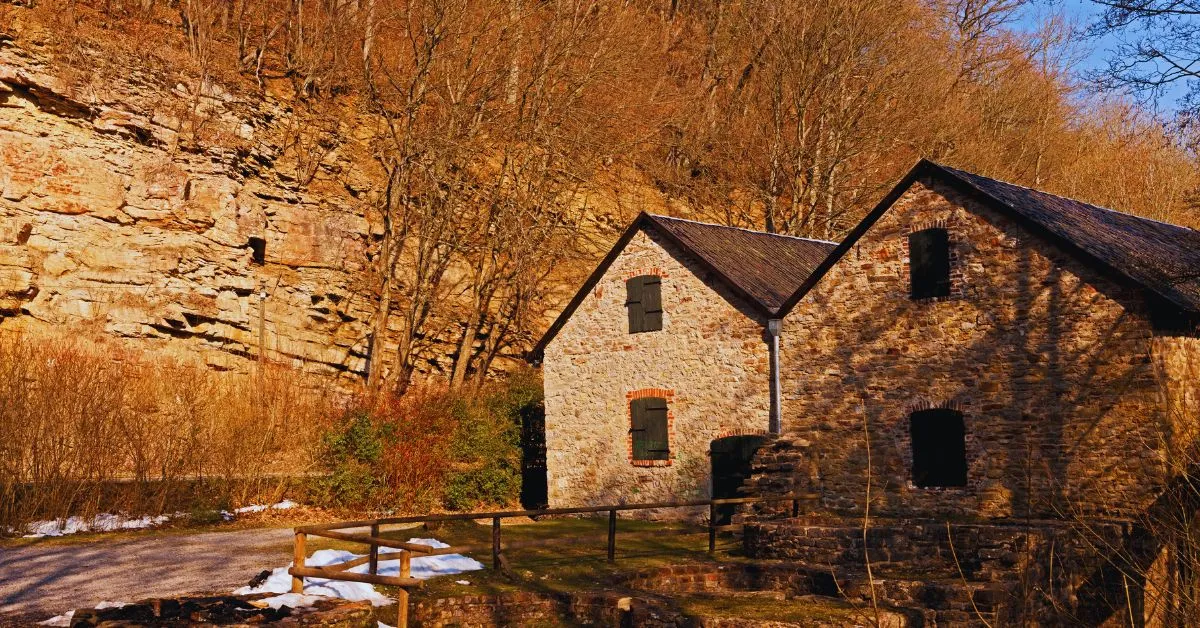Bone’s Gristmill Iowa: A Historic Landmark of Innovation and Tragedy
Nestled along the banks of the Boone River, a notable historic landmark once stood in Hamilton County, Iowa. Known as Bone’s Gristmill, this mill was more than a place for grinding grain; it was a hub of community activity, innovation, mystery, and tragedy. With its picturesque surroundings and strategic location, the mill became an integral part of the local landscape and played a significant role in its development.
The Early Days of Milling Along the Boone River
In the mid-19th century, the banks of the Boone River provided an ideal setting for a mill. The native walnut, oak, and maple timber created a natural beauty that attracted early settlers. Thomas Williams, one of these pioneers, arrived from Ohio in 1854 and constructed a sawmill near the future site of Bone’s Gristmill. Unfortunately, Williams’ mill was built in a location soon ravaged by spring floods, forcing him to move his equipment to a safer spot, where the foundation for Bone’s Gristmill would eventually be laid.
The Formation of the Mill and Its Evolution
As time passed, the mill site underwent several changes. Lambert Sternberg acquired the property and added a new dam made of logs and poles, enhancing the mill’s capacity by installing machinery for grinding wheat. The mill became a one-run operation with a single set of burrs powered by an old-fashioned Rose wheel. Standing about fourteen feet high, with a story-and-a-half structure above a basement, it quickly became a central point for settlers who traveled up to forty miles to grind their grain.
During this period, it was common for visitors to stay for days, sleeping in the mill, the miller’s office, or even the hay loft while waiting for their turn. The miller’s toll was typically every sixth bushel of wheat, and cash transactions were rare. The mill would often halt operations in late summer when the water levels were too low, causing long delays and stockpiles of grain.
Ownership Changes and a Dark Mystery
The property changed hands several times in the 1860s. Lambert Sternberg sold it to Jay Sternberg, who then sold it to John Ross in 1868. A dark chapter unfolded under Ross’s ownership when, in the summer of 1869, his body was found with a bullet wound in the back, lying in the wheel pit under the mill. Suspicion immediately fell on his nephew, John Ross Jr., who had recently requested a loan from his uncle and was denied. The nephew disappeared shortly after the incident, leading to his arrest and trial. Despite the circumstantial evidence, he was acquitted, and the mystery of Ross’s death remained unsolved.
Technological Advancements and New Ownership
Following the tragic events, the property reverted to Jay Sternberg in 1869, who sold it to James W. Kimbell in 1870. Kimbell modernized the mill by installing a Lafell turbine, a 48-inch water wheel that replaced the old Rose wheel. Transporting this heavy equipment was a challenge; the wheel, weighing three tons, had to be hauled over six miles using a rudimentary cart fashioned from an ox-cart axle and sawed-log wheels.
By 1871, the mill was owned by Joseph Bone, who would make significant improvements. Bone elevated the mill by twelve feet, added one-and-a-half stories, and installed new machinery to support the latest flour-making processes. The sawmill was removed to make space for the new equipment, transforming the site into the largest flouring mill along the Boone River.
A Flourishing Mill and a Touch of Romance
The mill, later renamed “Excelsior” to distinguish it from another mill owned by Bone, continued to thrive under the management of Bone and his son-in-law, A. D. McKinlay. Interestingly, Bone had a knack for retaining millers who would eventually become family. His first miller, James A. Snodgrass, married his eldest daughter, while McKinlay married another daughter. The mill served as a business and backdrop for family stories and local folklore.
During this period, a post office named “Tremaine” was established near the mill, serving the community until its eventual discontinuation. The mill became a local attraction, known for its wooden mechanisms’ soothing sounds and water splashing over the dam—a stark contrast to the harsher sounds of modern machinery.
The Decline and Final Days
Despite its success, the mill’s fortunes would eventually change. In 1889, it was sold to P. G. La Barr, who operated it until 1895, before selling it to P. B. Osborn. Osborn attempted to modernize the mill further by installing a boiler and steam engine. However, a devastating explosion in 1899 destroyed the engine and the building housing it, marking the end of the mill’s productive life. What machinery could be salvaged was moved to Osborn’s steam mill in Ellsworth, and the remaining land was sold off in small tracts.
The Legacy of a Bygone Era
Although the physical structure of Bone’s Gristmill no longer stands, its legacy symbolizes the pioneer spirit that shaped the Midwest. The mill was where people gathered, exchanged stories, and innovation took root. It witnessed the challenges and triumphs of early settlers, serving not just as a mill but as a cornerstone of the community.
Today, only memories and stories passed down through generations remain. The site where Bone’s Gristmill once stood has been converted into farmland, erasing the physical traces of its existence. Yet, for those who know its story, the mill represents a vital chapter in the history of Iowa, one filled with resilience, progress, and a touch of mystery.
Conclusion
The story of this once-thriving mill is a testament to the ingenuity and determination of the people who lived and worked there. From its early days as a humble sawmill to its prominence as a leading flour mill, the site played a crucial role in the local economy and community life. While the mill itself may be gone, the rich history and tales of Bone’s Gristmill continue to capture the imagination of those who seek to understand the past.
FAQs:
What was the primary function of the mill?
The mill primarily functioned as a gristmill for grinding grain and a sawmill in its early years.
What was unique about the operation of the mill?
It was known for its one-run operation with a single set of burrs, and it attracted settlers from up to forty miles away. The mill also used unique water wheel technology and underwent several ownership changes.
Why did the mill eventually close?
The mill closed after a steam engine explosion in 1899 destroyed vital parts of its infrastructure, rendering it unusable.
Who were some notable owners of the mill?
Notable owners included Lambert Sternberg, Jay Sternberg, John Ross, James W. Kimbell, and Joseph Bone, each of whom contributed to the mill’s development.
What remains of the mill today?
The physical structure has been lost, and the land is now used for farming. However, its legacy is preserved through historical accounts and local folklore.







